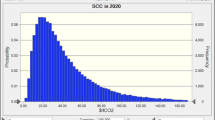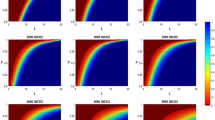Abstract
Within the framework of models for human-driven environmental impact based on the IPAT equation, we develop a model for the evolution of impact (expressed in terms of carbon dioxide emissions) and for the valuation of the economic cost associated to its reduction. We use a stochastic representation of the IPAT equation that is alternative to the STIRPAT model. This first step leads to a stochastic differential equations model that describes trends in carbon dioxide emissions on the basis of economic and demographic dynamics. As an example, we estimate the model parameters for the United States. We then use this framework to build a model for the assessment of the economic costs related to a reduction of carbon dioxide emissions for a country committed to respect an international agreement, such as the Kyoto protocol. In particular, we show that the adherence to an environmental treaty may be traced back to a problem of cost valuation and to a decision under risk. This allows us to use the mathematical tools that have been developed in quantitative finance, in the context of option pricing, to determine the expected investment that is required to reduce the emissions of a country by a certain amount and within a well-defined temporal frame.




Similar content being viewed by others
Notes
Data source: World Bank.
References
Auffhammer, M., Carson, R. T., & Garin-Muñoz, T. (2004). Forecasting China’s carbon dioxide emissions: A provincial approach. Department of Agricultural & Resource Economics, UCB. CUDARE Working Paper 971.
Black, F., & Scholes, M. (1973). The pricing of options and corporate liabilities. Journal of Political Economy, 81, 637–654.
Commoner, B. (1972). The environmental cost of economic growth. In R. G. Ridker (Ed.), Population, Resources and the Environment (pp. 339–363). Washington, DC: U.S. Government Printing Office.
Dietz, T., & Rosa, E. A. (1994). Rethinking the environmental impacts of population, affluence and technology. Human Ecology Review, 1, 277–300.
Dietz, T., & Rosa, E. A. (1997). Effects of population and affluence on CO2 emissions. Proceedings of the National Academy of Sciences of the USA, 94, 175–179.
Ehrlich, P., & Holdren, J. (1971). Impact of population growth. Science, 171, 1212–1217.
Intergovernmental Panel on Climate Change (IPCC) (2007). Climate change 2007. Fourth assessment report. Un-edited copy prepared for COP-13.
Kwon, T.-H. (2005). Decomposition of factors determining the trend of CO2 emissions from car travel in Great Britain (1970–2000). Ecological Economics, 53, 261–275.
MacKellar, F. L., Lutz, W., Prinz, C., & Goujon, A. (1995). Population, households and CO2 emissions. Population and Development Review, 21(4), 849–865.
Merton, R. (1973). Theory of rational option pricing. Bell Journal of Economics and Management Sciences, 4(1), 141–183.
Øksendal, B. (2000). Stochastic differential equations. An introduction with applications. Springer.
O’Neill, B. C. (2003). Economics, natural science, and the costs of global warming potentials. Climatic Change, 58(3), 251–260.
O’Neill, B. C., & Chen, B. S. (2002). Demographic determinants of household energy use in the United States. Population and Development Review, 28(Supplement: Population and Environment: Methods of Analysis), 53–88.
O’Neill, B. C., MacKellar, F. L., & Lutz, W. (2001). Population and climate change. Cambridge University Press.
Rosa, E. A., & York, R. (2002). Internal and external sources of environmental impacts: A comparative analysis of the EU with other nation groupings, National Europe Centre Paper No. 22, Paper presented to conference on The European union in international affairs, National Europe Centre, Australian National University.
Schulze, P. C. (2002). I=PBAT. Ecological Economics, 40, 149–150.
Tuljapurkar, S. (1990). Population dynamics in variable environments. In S. Levin (Managing Editor), Lecture notes in biomathematics 85. Springer-Verlag.
York, R., Rosa, E. A., & Dietz, T. (2003). STIRPAT, IPAT and ImPACT: Analytic tools for unpacking the driving forces of environmental impacts. Ecological Economics, 46, 351–365.
Zagheni, E. (2004). Models of environmental impact based on the IPAT equation: An analysis and some new proposals. Milano: Tesi di Laurea in Scienze Economiche, Statistiche e Sociali, Università Commerciale Luigi Bocconi.
Author information
Authors and Affiliations
Corresponding author
Rights and permissions
About this article
Cite this article
Zagheni, E., Billari, F.C. A cost valuation model based on a stochastic representation of the IPAT equation. Popul Environ 29, 68–82 (2007). https://doi.org/10.1007/s11111-008-0061-1
Published:
Issue Date:
DOI: https://doi.org/10.1007/s11111-008-0061-1




